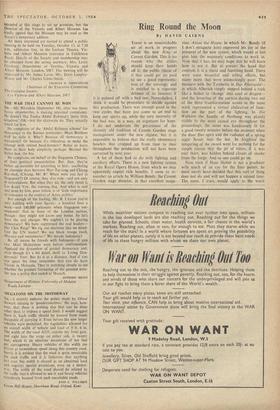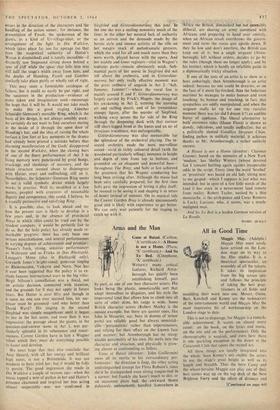Ring Round the Moon
By DAVID CAIRNS
THERE is an unmistakable air of work in progress about the new Ring at Covent Garden. This is no reason why the critics should keep their hands off it; the public (those of it that could get in) paid to see a good representa- tion of the tetralogy and is entitled to a vigorous defence of its interests if it is palmed off think it would this production. two cycles that have just come to an end to keep our spirits up, while the very enormity of the bad was, in a way, an argument for hope. I do not underrate the persistence of the slovenly old tradition of Covent Garden stage management under the new rdgime; but it is impossible to believe that the really elementary howlers that cropped up from time to time throughout the production will not have been corrected by next year.
A lot of them had to do with lighting and ancillary effects. There is a new lighting system at the Royal Opera House, from which we may apparently expect rich benefits. I seem to re- member an article by William Bundy, the Covent Garden stage director, in that excellent maga- with a bad One. Nevertheless, I
be premature to decide against There was enough good in the
zine, About the House, in which Mr. Bundy (if I don't misqudte him) expressed his joy at the prospect of the new system, which would at last give him the necessary conditions to work in. Now that it has, we may hope that he will learn how to use it. But at present the hand that controls it is a timid and fumbling hand. There were some beautiful and telling effects, but many more that were astonishingly poor. The business with the Tarnhelm in Dos Rheingold- in which Alberich simply stepped behind a rock like a bather to 'change' into toad or dragon— and the lowering of the curtain during two out of the three transformation scenes in the same work represented a virtual abdication of func- tion on the part of the lighting. In Die Walkfire the handle of Nothung was plainly visible to the most casual eye throughout the proceedings; the scene was handsomely lit for a good twenty minutes before the moment when the door flies open and the radiance of a spring night- floods into the hut. In Siegfried the tempering of the sword went for nothing for the simple reason that the jet of steam, if it was ever there, was hidden behind clouds of smoke from the forge. And so one could go on.
Now even if Hans Hotter is not a producer with much of an eye for the finer points, he must surely have decided that this sort of thing does not do and will not happen a second time. The same, I trust, would apply to the worst errors in the direction of the characters and the handling of the action scenes: for instance, the presentation of Fasolt, the spokesman of the giants, as a kind of Ur-village-idiot, or the arrangement of the fight in Die Walkiire, which takes place far too far upstage (so that even the majestical authority of Hotter's Wotan is diminished) and is totally incredible—I distinctly saw Siegmund sitting down behind a spur of cliff while the spear that fells him was still half the stage's width away from him; and the deaths of Hunding, Fasolt and Gunther similarly take place partly or wholly out of sight.
This may seem a formidable catalogue of failure, but it could so easily be put right, and the successes in the production—evidence of Pains taken and imagination used—encourage the hope that it will be. It would not take much to make this a good staging. Gtinther Schneider-Siemssen's movable Ring, which is the basis of his design, is not always sensibly used: we certainly do not want to find ourselves staring at the inside of it through the open door of Hunding's hut, and the idea of raising the whole surface a few feet at key moments in the drama had already been proved a mistake before that alarming manifestation of the Gods' disapproval in the second Walkiire, when the closing bars of one of the finest performances of Act 3 in living memory were punctuated by great bangs, crackings and sheddings of masonry, and the whole structure seemed about to disintegrate with dotter, erect and unflinching, still on it. Nevertheless, the Schneider-Siemssen Ring seems to me a valid symbolic device which largely works in practice. Well lit, • modified at a few Points, peopled with creatures of reasonable dignity and competence, this could, I believe, be a visually persuasive and satisfying Ring.
It is possible. also, to look ahead and see how the present cast is likely to develop in a few years and, in the absence of provincial Rings in which Coles could be tried out by the resident company, it would be perfectly fair to do so. But the Solti policy has already made re- markable progress; there has only been one serious miscalculation, and several performances in varying degrees of achievement and promise: Veasey's fresh, strong, sensitive performances as Waltraute and as Fricka in Das Rheingold, Lanigan's Mime (also in Rheingold only), Gwyneth Jones's bright-toned, generous singing as Rhinemaiden, Valkyrie and Norn. Nor has it ever been suggested that the policy is to ex- clude famous international stars in the big roles; Birgit Nilsson's cancellation was a fiscal, not an artistic decision, connected with taxation, and the grounds for it may not apply in future Years. But Hotter is over fifty and though in a sense no one can ever succeed him, his suc- cessor must be groomed—and who better than David Ward? His singing in the second Siegfried was simply magnificent until it began to tire in the last scene, and even then it was impressive; the passage about the giants, in the question-and-answer scene in Act 1, was par- ticularly splendid in its vehemence and sonor- ousness. Covent Garden have in him a Wagner talent which they must do everything possible to foster and develop.
We must hope that they also conclude that Amy Shuard, with all her energy and brilliant high notes, is not a' Britnnhilde. It was not madness to have tried her; but it would be folly to persist. The good impression she made in Die Walkiire a couple of seasons ago—when the music tapped a vein of pathos in her and•Hotter's presence chastened and inspired her into acting almost respectably—was not confirmed in
Siegfried and Gotterdiimmerhng this year. In the one she was a smiling nonentity much of the time; in the other her natural lack of authority as an actress and the demands made by the heroic style and intense activity of the role on her meagre stock of melodramatic gestures, which she used for all and much more than they were worth, played havoc with the opera. And her middle and lower registers—vital in Wagner's soprano parts—remain obstinately weak. Sub- stantial parts of her music in Siegfried did not tell above the orchestra, and in GOtterdam- merung her only really effective moment was the great outburst of anguish in Act 2----`Ach, Jammer, Jammer!'—where the vocal line is mainly around E and F. Gotterdiimmerung was largely carried by Frick's Hagen; the image of his awakening in Act 2, scenting the morning air and sniffing deceit, and of his tremendous stumpy figure, after the murder of Siegfried. walking away across the far side of the Ring through the deepening dusk with that curious stiff short-legged bend at the knees and an air of ferocious truculence, was unforgettable.
Gotterdiimmerung was also memorable for the splendour of the orchestral playing. The re- seated orchestra made the Most marvellous sound—vivid in richly coloured detail (with the woodwind particularly telling), immense in height and depth of tone from top to bottom, and grounded on an eloquent and powerful bass— throughout The Ring; and Solti at last achieved the greatness that his Wagner conducting has long been striving after. Although the music had been very carefully prepared, for the first time Solti gave the impression of letting it play itself; he seemed to be seeing it and shaping it in terms of hours instead of minutes. On its musical side the Covent Garden Ring is already uncommonly good and is likely with experience to get better. We can only wait patiently for the staging to catch up with it.















































 Previous page
Previous page